The Cultural differences between Afro-Guyanese and Africans
Globalization and heavy western influences since colonial days have indeed taken a toll on the rich African culture.
In many countries, the strands of the culture are still evident, as is the case with Guyana.
And even though the strong characteristics of the culture are taking a new identity with modern times, many of its other features remain preserved and celebrated in many African countries.
To date, Africa still remains, culturally and ethnically the most diverse on the planet and true to its roots.
Here is a look at how Afro-Guyanese differ culturally to their African brothers and sisters in Africa.
Living in tribes
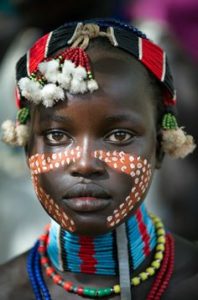
Unlike the Amerindians who ‘somewhat’ still live in tribes, Afro-Guyanese has lost this part of their culture: something which can be attributed to the distribution of the country’s ethnic composition.
In many African countries, tribes are in abundance. Countries as small as Uganda, for example, have more than 30 tribes, each with their own unique language and way of life. There are currently 410 well-known tribes listed but added to the ‘not so popular’ ones, the tribes said to be in the thousands.
But this does not prevail in Guyana in spite of the fact that Afro-Guyanese with tribal names has been able to trace their ancestral lineage back to Mother Africa.
Art
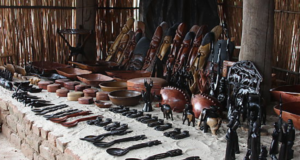
Africa has a rich tradition of arts and crafts. Their beliefs and stories are told beautifully through a variety of woodcarvings, brass and leather artworks. African arts and crafts also include sculpture, paintings, pottery, ceremonial and religious headgear and dress. But most of the sculptures are designed to be socially functional.
Art is also becoming a fusion of traditional and modern techniques but artists still draw inspiration from the masks, statues and figurines of tribal culture. Additionally, art forms in Africa such as textiles perhaps retain the strongest links to traditional black culture, because they express identity and shared history.
While several persons do collect such pieces, this is not extensively practiced in Guyana.
Guyana art is mostly imaginative and when it is cultural, focuses on a variety of topics like the fusion of the six ethnic groups and the journey from the past to the successes of each race to date.
Dancing
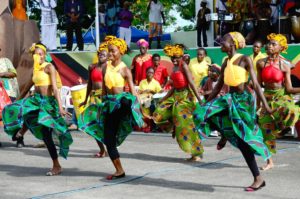
Dance for Africans is a spiritual expression of the soul. It is filled with meaning and joy. There are various styles which are influenced by various tribal customs. It is one of the features of the African culture which remained untainted for several decades in many African states.
For example, Gumboot dancing was born in the mines of South Africa, where Africans were given Wellingtons to protect their feet and communicated in the dark by slapping and thudding their boots.
Different parts of the body are emphasised by various groups. The upper body is emphasised by the Anto-Ewe and Lobi of Ghana. Subtle accent of the hips is characteristic of the Kalabari of Nigeria. In Agbor strong contraction-release movements of the pelvis and upper torso characterise both male and female dancing. The Akan of Ghana use the feet and hands in specific ways.
In Guyana, some African-inspired movements are not done with any specific meaning though the rhythm and the gyrations may be very similar even when performed on the modern day dance floor.
But the rich and traditional movements of African dances are known to be extremely salacious and racy; most of them are not evident in Afro-Guyanese dance movements.
Folklore
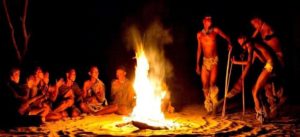
Folklore is an important feature of the African heritage. Their stories represent the passing down of precious stories that keep each generation closely knit, to remember the past and charter the future with a deep sense of identity.
African folklore and religion represent a variety of social facets of the various cultures in Africa. Different ethnic groups in Africa have different rituals or ceremonies for storytelling, which creates a sense of belonging to a cultural group.
There are different types of African folklores about animal tales which are more oriented towards entertainment, but still, have morals and lessons to them. Animal tales are normally divided into trickster tales and ogre tales. In the animal tales, a certain animal would always have the same character or role in each story so the audience does not have to worry about characterization. The Hare was always the trickster, clever and cunning, while the Hyena was always being tricked by the Hare.
Day-to-Day folklores as they would call it, are the most serious tales, never including humour, that explained the everyday life and struggles of an African community. These tales take on matters such as famine, escape from death, courtship, and family matters, using a song form when the climax of the story was being told.
Folklores of Afro-Guyanese are quite different to those in Africa. Some include the tale of the Massacoorman, a frightening evil spirit which lives Upper Demerara and Guyana. This is a water monster that is generally active in the late evening as the sun sets. The only ambition of this devil is to drag you from the river bank, drowning and breaking your neck. It is believed that the tale of the Massacoorman has its origins in slavery. It is said that when Slaves ran away from the plantations they used the vast waterways of Guyana to escape deeper into the interior. The plantation owner would let loose his slave trackers to hunt and capture them but they would be killed by the African slaves in the waterways.
Cuisine
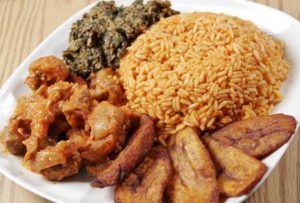
As it relates to food, one could easily observe that there are striking differences. Various cuisines of Africa use a combination of locally available fruits, cereal grains and vegetables, as well as milk and meat products. In some parts of the continent, the traditional diet features a prevalence of milk, curd and whey products.
In much of tropical Africa, however, cow’s milk is rare and cannot be produced locally (owing to various diseases that affect livestock). The continent’s diverse demographic makeup is reflected in the many different eating and drinking habits, dishes, and preparation techniques of its manifold populations.
In Central Africa, the basic ingredients are plantains and cassava. A variety of local ingredients are used while preparing other dishes like spinach stew, cooked with tomato, peppers, chillis, onions, and peanut butter. Cassava plants are also consumed as cooked greens. Groundnut (peanut) stew is also prepared, containing chicken, okra, ginger, and other spices. Another favourite is Bambara, a porridge of rice, peanut butter and sugar.
In Guyana, African dishes do not include a mixture of peanut. Some of these dishes locally, include Metemgee which is a thick rich type of soup with ground provisions, coconut milk and large dumplings (called Duff), eaten with fried fish or chicken and Conkie, a sweet cornmeal based food cooked by steaming in banana leaves.






